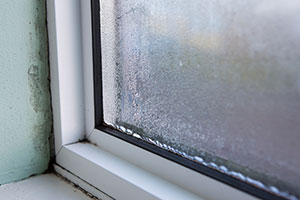Condensation is a topic that continues to dominate the housing agenda, as misdiagnosis and tenant behaviour patterns contribute to the worsening problem. With the Homes (Fitness for Human Habitation) Act 2018 putting pressure on landlords to act, Paul Harrington, Head of Residential Sales at Elta Fans, highlights the major issues surrounding condensation, and how landlords should go about tackling the problem.
The importance of raising awareness surrounding condensation issues amongst landlords is best highlighted with the numbers: 20% of UK households are privately rented, with a further 17% being social housing. That means that over 1/3 of UK households operate with a tenant-landlord relationship, with occupants reliant upon their landlords to fix issues with the property.
The introduction of the Homes Act has given tenants greater power to action change, as it seeks to ensure that rented properties are fit for human habitation, or in other words, safe, healthy and free from things that could cause serious harm. In cases where tenants do not feel their property is adequately maintained, they can take the matter to court, who will then decide if it is fit for human habitation by considering matters which are set out in section 10 of the Landlord and Tenant Act 1985.
Condensation is one of the most common issues for landlords, especially during the colder autumn and winter months. It occurs when excess water vapour condenses on cold surfaces, such as external walls and windows, and can lead to a type of mould that has damaging effects on both health and structural integrity.
According to the Local Government Association, the NHS spends £2.5 billion a year treating people with illnesses directly linked to living in cold, damp conditions. This highlights the extent of the problem, and why it is crucial that landlords and contractors get to grips with the causes and cures to condensation.
Tenant behaviour
The main reason that condensation is so prevalent in rented housing is its intrinsic link to occupant behaviour. There are a range of activities that worsen instances of condensation, many of which are exacerbated in social housing conditions. Drying clothes indoors, for example, is something that is unavoidable for anyone who doesn’t have the luxury of an outdoor space, yet it is a major contributor to condensation.
Another significant challenge in the fight against condensation is the increasing inability of tenants to afford heating bills. According to the Department for Business, Energy & Industrial Strategy, 11% of UK households exist in fuel poverty, which means that houses are colder than they should be. Aside from the direct health implications of living in cold conditions, it also has a knock-on effect in terms of increasing condensation.
This outlines the scale of the challenge for landlords, who in many cases have little to no control over what their tenants do. It does, however, emphasises the importance of being responsive to condensation issues as they arise, especially in light of the Homes Act.
Misdiagnosis
Another layer of difficulty is that condensation is often misdiagnosed as damp. Either at the stage of being reported by tenants, or upon landlord inspection, dampness is often identified as the problem, and subsequent damp-orientated solutions progressed at great expense.
It is important that landlords are able to tell the difference, to prevent wasting money on more expensive measures such as removing perfectly good plaster. There is also an onus on damp experts to be proactive when attending call outs, as they are increasingly confronted with symptoms of condensation.
Damp proofers are able to inform landlords of instances where it is condensation rather than damp, and recommend measures to alleviate the issue. Courses on combatting condensation are frequently populated with damp professionals, seeking to expand their expertise and get to grips with how to fight the issue.
Steps for change
The preferred method to reduce condensation is to produce less moisture within structures. However, in circumstances where this is not possible, the optimum solution is to remove more moisture through effective ventilation. This must be balanced with the need for energy efficiency, in order to prevent fuel poverty issues from worsening.
Intelligent PIV units, such as Elta Fans’ SANO Intelligent PIV, are capable of automatically adjusting air flow depending on the moisture content and temperature of incoming air during the winter months. This ensures optimal thermal comfort for tenants, without incurring the high energy costs associated with using a heater, and integral controls allow the unit to be responsive to the individual requirements of a home.
A changing landscape
Building regulations have stayed largely the same for several years, at least in relation to condensation. It is also true that the types of behaviour that increase instances of condensation are roughly the same as ever. The key change for landlords, and indeed anyone associated with the fight against condensation, is the landscape in which they operate.
This refers to both the increased insulation of our structures, which reduces natural ventilation, but also to the new levels of power that tenants have. The Homes Act has understandably shifted the spotlight onto housing providers, and therefore the conditions of their properties.
Everyone has a responsibility to understand the symptoms, causes, and treatments for condensation, whether they are a landlord, damp proofer, or anyone associated with delivering ventilation to a home. To help with this, Elta Fans has created a guide to combatting condensation, which can be found here: https://www.eltafans.com/divisions/residential/combatting-condensation/
Details on residential training courses cam be found here: https://www.property-care.org/training-qualifications/training-courses/residential-veon-masterclass/
- Log in to post comments















